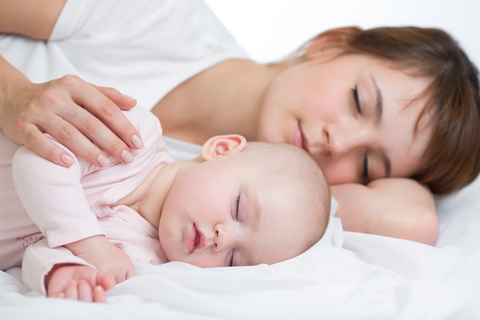
If you’ve heard about co-sleeping but you just aren’t sure how to co-sleep with your baby, we have the basics for you.
Once you know the basics, you’ll realize how easy it is to satisfy the needs of baby and parent.
Among my fondest of parenting memories is sleeping with a baby on one side an a toddler on the other, feeling warm next to my two children, falling asleep loving them so much I could burst.
How to Co-sleep
Designate a space. The baby shouldn’t go between two adults. I put my baby on the outside of me, toward the wall, and my toddler between me and my husband. When our babies were a bit older, we also used sheepies from our cousins in New Zealand (and ALL babies in New Zealand sleep on sheepskins), so the sleeping space was clearly marked. My sheepie = my space.
Get rid of heavy covers. Not only can heavy blankets or comforters be a risk for your baby, most babies will wiggly off even a light blanket. A baby sleeping bag will keep your baby warm. You might wish for your own sleeping bag.
Remove pillows. Usually your baby will be sleeping lower than your pillow (mouth to breast, most likely), but make sure there is no chance of your baby creeping under a pillow. If you can sleep without, you can prevent that happening.
Separate the siblings. When your baby is young (under one year), you should separate siblings. Your baby needs a responsible adult nearby.
Remove toys. First of all, very young babies don’t need toys. More important, you shouldn’t have hard or soft objects like that near the sleeping space.
Should You Co-Sleep with Your Baby?
You are the one who should decide. You will probably get opinions from healthcare providers, family, and others. Just make sure you understand that we are emerging from an era of pressure NOT to sleep anywhere near our children into a time of more open acknowledgment of the benefits of co-sleeping.
Even Dr. Richard Ferber, for whom “Ferberizing” (the cry-it-out method of sleep training) is named, changed his mind about co-sleeping in his 2006 revision of his oft-misused book on infant sleep. He acknowledges that there are many healthy ways for a family to sleep.
Knowing this, you can look for opinions that are based in the 21st century and based on fulfilling the needs of babies and families.
In addition to giving your baby what she or he wants—YOU—sleeping near one another makes your life easier.
For breastfeeding mothers, it is so convenient to have your baby right next to you at night. You don’t need to wake up all of the way, get up in the cold, go to a differet room to answer a baby who is distressed enough to cry so you will hear. Baby fusses, mother wakes enough to feed the baby, then everyone falls back asleep.
When You Shouldn’t Co-sleep with Your Baby
There can be risks when a big person sleeps next to a small person or when a small person could slip into soft spaces. If any of the risks are present, co-sleeping is not recommended.
Some issues involve the bed and bedding. Do not co-sleep with:
- No bed. Do not sleep with your baby on a soft surface when the baby can slip into spaces (such as between cushions).
- Loose pillows
- Heavy blankets or covers
Some issues involve the adult sleeping with the baby. The adult nees to be able to wake easily. Do not co-sleep if:
- Adult is a smoker
- Adult has been drinking or has taken drugs, even prescription sedatives
- Adult is over tired
- Adult is morbidly obese
In some of these situations, you can still have your baby nearby on a separate surface without risk.
More Co-sleeping Help
Because there is so much misinformation about babies and sleep in western cultures, it has taken some time to pull the norm back to a place it can benefits babies and families.
One place working to help parents and healthcare providers get accurate research on normal, healthy sleep is the Mother-Baby Behavioral Sleep Laboratory at University of Notre Dame. Their focus is “how sleeping environments reflect and respond to family needs—in particular how they affect mothers, breastfeeding, and infants’ physiological and psychological well-being and development.”
If you want to know more about the science of sleeping next to a baby, this is a great resource. If you need information (downloadable articles, links to videos) for family or doctor, you will find those here as well.
Also, Dr. Sears (the multiple Drs. Sears) share stories of co-sleeping from their own family and from parents in “Co-sleeping: Yes, No, Sometimes?”
Why Co-sleeping
Last week, in our post “Helping Your Baby Sleep with Love and Compassion,” we mentioned co-sleeping or family bed—the practice of sleeping with your child. This post was more about the fact that co-sleeping helps a lot of families get more sleep more calmly. It touches on why families share a bed.
That got us thinking that some parents might just be looking for a basic how-to guide. We hope this helps.
If you are interested to know how the North American reluctance to share a family bed compares to the rest of the world, I repeat my recommendation that you read Christine Gross-Loh’s Parenting Without Borders: Surprising Lessons Parents around the World Can Teach Us (2013). The chapter “Sleep Time: Keep Our Babies Close or Give Them Space?” is a gentle survey of world practices.
Image © Oksun70 | Dreamstime.com
